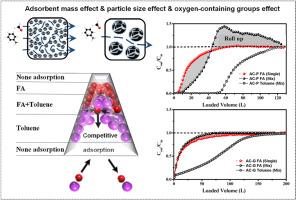Assessment of interfering/synergistic effects in the adsorption between polar and non-polar VOCs on a commercial biomass-based microporous carbon
IF 8.1
2区 环境科学与生态学
Q1 ENVIRONMENTAL SCIENCES
引用次数: 0
Abstract
This research has been carried out to investigate unique relationships in adsorption behavior between polar and non-polar volatile organic compounds (VOCs: formaldehyde (FA) versus toluene) using commercial macadamia nutshell (MNS)-based microporous activated carbon (i.e., Procarb-900: namely, P900). The breakthrough (BT) volume, adsorption capacity, and partition coefficient of P900 are estimated for 100 ppm FA as a single component and as a binary phase with 100 ppm toluene. The contrasting features of adsorption (such as interfering/synergistic relationships) for VOC mixtures with different polarities are accounted for in terms of interaction between the key variables (e.g., pore size distribution, adsorbent particle size, surface element compositions, and sorbent bed mass). Accordingly, the powdered P900 (0.212–0.6 mm: 150 mg) exhibits an adsorption capacity of 5.7 mg g−1 and a partition coefficient of 0.19 mol kg−1 Pa−1 for single-phase FA at the 10% BT level. Interestingly, its FA adsorption performance is synergistically improved in the presence of toluene (e.g., > 150%) in the early stage of adsorption (e.g., 10% BT), although their competition reduced its performance at 99% BT. The apparent synergistic trend in the early BT stage may possibly reflect diffusion resistance of the adsorbent (e.g., small particle size and developed ultra-micropore structure) and natural attributes of FA (e.g., low affinity and smaller kinetic diameter). The overall results of this study are expected to offer a better understanding of the mechanisms underlying the interactions between the mixed VOC system and microporous adsorbents.

评估极性和非极性挥发性有机化合物在商用生物质微孔碳上吸附时的干扰/协同效应。
本研究使用基于商用澳洲坚果壳(MNS)的微孔活性炭(即 Procarb-900:即 P900),对极性和非极性挥发性有机化合物(VOC:甲醛(FA)和甲苯)之间的吸附行为的干扰/协同关系进行了研究。我们估算了 P900 在 100 ppm FA 作为单组分和 100 ppm 甲苯作为二元相时的突破 (BT) 量、吸附容量和分配系数。从关键变量(如孔径分布、吸附剂粒度、表面元素组成和吸附剂床层质量)之间的相互作用角度,说明了 P900 吸附剂对 FA 吸附的基本特征。因此,粉末状 P900(0.212-0.6 毫米:150 毫克)的吸附容量为 5.7 毫克 g-1,在 10% BT 水平下,对单相 FA 的分配系数为 0.19 摩尔 kg-1 Pa-1。有趣的是,在吸附的早期阶段(如 10% BT),当甲苯存在时(如 >150%),它的性能得到了协同改善,这可能反映了吸附剂的扩散阻力(如小粒径和发达的超微孔结构)和 FA 的天然属性(如低亲和力和较小的动力学直径)。这项研究的总体结果有望让人们更好地了解混合挥发性有机化合物体系与微孔吸附剂之间的相互作用机制。
本文章由计算机程序翻译,如有差异,请以英文原文为准。
求助全文
约1分钟内获得全文
求助全文
来源期刊

Chemosphere
环境科学-环境科学
CiteScore
15.80
自引率
8.00%
发文量
4975
审稿时长
3.4 months
期刊介绍:
Chemosphere, being an international multidisciplinary journal, is dedicated to publishing original communications and review articles on chemicals in the environment. The scope covers a wide range of topics, including the identification, quantification, behavior, fate, toxicology, treatment, and remediation of chemicals in the bio-, hydro-, litho-, and atmosphere, ensuring the broad dissemination of research in this field.
 求助内容:
求助内容: 应助结果提醒方式:
应助结果提醒方式:


